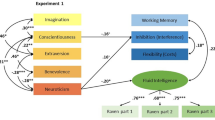Abstract
Two groups of college students that scored high (N=25) and low (N=60) on a schizotypal personality index based on the Perceptual Aberration, Magical Thinking, and Schizotypal Personality Scales, were tested for hemisphericity using a dichotic listening task and completed the Torrance Test of Creative Thinking. The schizotypy scales correlated with high scores on the nonverbal portion of the creativity tests and with a left ear preference to dichotically presented verbal stimuli. The Torrance Test of Creative Thinking did not correlate, however, with hemispheric asymmetry. These results clarify the relationship between schizotypy and creating thinking abilities but fail in establishing the role of hemispheric asymmetry in the production of creative thinking ideas.
Similar content being viewed by others
References
Andreasen, N. C. (1978). Creativity and psychiatric illness.Psychiatric Annals, 8(3), 23–45.
Annett. (1967).The bimodal distribution of right, mixed and left handedness.
Broks, P. (1984). Schizotypy and Hemisphere Function-II. Personality and Individual Differences,5(6), 649–656.
Broks, P., Claridge, G., & Matheson, J. (1984). Schizotypy and Hemisphere Function-IV. Personality and Individual Differences,6(6), 665–670.
Chapman, L. J., Edell, W. S., & Chapman, J. P. (1980). Psychical anhedonia, perceptual aberration, and psychosis proneness.Schizophrenia-Bulletin, 6(4), 639–653.
Claridge, G., & Broks, P. (1984). Schizotypy and Hemisphere Function-I.Personality and Individual Differences, 5,(6), 633–648.
Dunn, L. M., & Dunn, L. M. (1981).Manual for the Peabody Picture Vocabulary Test-revised. Circle Pines, MN: American Guidance Services.
Dykes, M., & McGhie, A. (1976). A comparative study of attentional strategies of schizophrenic and highly creative normal subjects.British Journal of Psychiatry, 128, 50–56.
Edell, W. S., & Chapman, L. J. (1979). Anhedonia, perceptual aberration, and the Rorschach.Journal of Consulting and Clinical Psychology, 47(2), 377–384.
Galton, F. (1892).Hereditary genius. London: Macmillan and Company.
Katz, A. N. (1983). Creativity and individual differences in asymmetrical cerebral hemispheric functioning.Empirical Studies of the Art, 1(1), 3–16.
Lenzenweger, M. F. (1991). Confirming schizotypic personality configurations in hypothetically psychosis-prone university students.Psychiatry Research, 37(1), 81–96.
Lombroso, C. (1891).The man of genius. London: Walter Scott.
Martindale, C., Hines, D., Mitchell, L., & Covello, E. (1984). EEG alpha asymmetry and creativity.Personality and Individual Differences, 5(1), 77–86.
Overby, L. A. (1992). Perceptual asymmetry in psychosis-prone college students: Evidence for left-hemisphere overactivation.Journal of Abnormal Psychology, 102(1), 96–103.
Poreh, A. M., & Whitman, D. R. (1991). Creative cognitive processes and hemispheric asymmetry.Journal of Creative Behavior, 25(2), 169–179.
Raine, A., & Manders, D. (1988). Schizoid personality, inter-hemispheric transfer, and left hemisphere over-activation.British Journal of Clinical Psychology, 27(4), 333–347.
Rawlings, D., & Borge, A. (1987). Personality and hemispheric function: Two experiments using dichotic shadowing technique.Personality and Individual Differences, 8(4), 483–488.
Richards, R., Kinney, D. K., Lunge, I., Benet, M., & Merkel, A. (1988). Creativity in manic-depressives, cyclothymes, their normal relatives, and control subjects.Journal of Abnormal Psychology, 97(3), 281–288.
Richards, R. L. (1981). Relationships between creativity and psychopathology: An evaluation and interpretation of the evidence.Genetic Psychological Monographs, 103(2), 261–324.
Rust, J., Golombok, S., & Abram, M. (1989). Creativity and schizotypal thinking.Journal of Genetic Psychology, 150(2), 225–227.
Schuldberg, D., French, C., Stone, L., & Heberle, J. (1988). Creativity and schizotypal traits: Creativity test scores and perceptual aberration, magical ideation, and impulsive nonconformity.Journal of Nervous and Mental Disease, 176(11), 648–657.
Torrance, E. P. (1974).Torrance Test of Creative Thinking: Norms and technical manual (1st ed.). Lexington, MA: Personal Press.
Woody, E. Z., & Claridge, G. S. (1977). Psychoticism and thinking.British Journal of Social and Clinical Psychology, 16(3), 241–248.
Author information
Authors and Affiliations
Additional information
This article is based on a portion of the first author’s dissertation at Wayne State University.
Rights and permissions
About this article
Cite this article
Poreh, A.M., Whitman, D. & Ross, T.P. Creative thinking abilities and hemispheric asymmetry in schizotypal college students. Current Psychology 12, 344–352 (1993). https://doi.org/10.1007/BF02686814
Accepted:
Issue Date:
DOI: https://doi.org/10.1007/BF02686814



